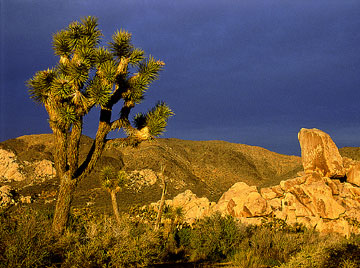 Inside Out
Inside Out
By Nick Gnu Gerlich, crew chief for Bill Praying Mantis Pratt-Steele
The desert is one of the most interesting places on earth. One will not find much evidence of life teeming about, creeping and crawling, jumping and flying out of the barren landscape. No, in the desert, life is hidden.
But it is there. It has its own defenses to ensure it can sustain what may be among the harshest of weather conditions on the planet. Appearances say the desert is dead, but it only looks that way. You just have to know where to look.
My favorite place in all of the U.S. is the Mojave. I don't know what it is that beckons. Many people call it a God-forsaken place, and at first glance they're probably not far off. It's lonely. It's rugged. And the palette of earth tones all blends together into the horizon, broken only by an occasional joshua tree or creosote bush. Eden it is not. Adam and Eve would have hated this place. There are no fig leaves.
But we come back every year at least once to take a sabbatical amid the lonely and the rugged. It is a place to reflect, to soak up the solitude, to embrace the beauty of simplicity. It is in the desert where you really learn to taste the water and appreciate the life-sustaining capability of it. And it is in the desert that the only person you may meet is yourself.
The desert must be experienced outside the air conditioned environs of an automobile running along at 70. It must be smelled. It must be felt. It must be traversed by human power alone. And as Edward Abbey revealed in his opus Desert Solitaire, in a dark time the eye begins to see.
Bill had been preparing for this vision quest all year. It wasn't his first. In fact, you could say that he's been on a never-ending journey since 2001 when he was plowed down by Bubba Red Neck in south Texas. Nothing beats getting run over by a dually when all you have is a bicycle helmet and 20 pounds of carbon fiber and wheels to protect you. Neck broken and vertebrae crushed, Bill remained home-bound for several months before he could ever think of living normally again, much less remounting a bike.
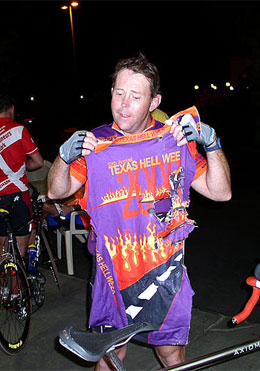 But he did, and set his sights on an epic journey in 2003 that would make most casual athletes shudder: The 508, a 48-hour bicycle race through the Mojave in southern California. Non-stop. 508 miles, from LA to 29 Palms via Death Valley. You, your bike, and the desert. You can see the other riders, but you can't ride with them. Solitary refinement, except that each rider must have a crew running along in the van behind, kind of like an untethered IV bag of sustenance.
But he did, and set his sights on an epic journey in 2003 that would make most casual athletes shudder: The 508, a 48-hour bicycle race through the Mojave in southern California. Non-stop. 508 miles, from LA to 29 Palms via Death Valley. You, your bike, and the desert. You can see the other riders, but you can't ride with them. Solitary refinement, except that each rider must have a crew running along in the van behind, kind of like an untethered IV bag of sustenance.
Bill finished that ride in 38 hours and 19 minutes. He had stashed in the pace van the tattered orange and purple jersey he was wearing the day he was hit by that truck. On race day he wore an identical jersey to symbolize that his life was continuing from that dreadful March day two years prior. At the finish line we pulled out that torn old jersey and gave it to Bill, who held it over his head in victory. Astride a fancy titanium bike that Bubba Red Neck's insurance company had paid for, Bill learned that he was alive and well in the desert. He may have looked dead after that wreck, and he certainly had his moments of despair while pedaling through the lunar landscape of the Mojave, but standing at the finish line in 29 Palms he was absolutely oozing in life.
Having learned about living and himself, Bill went home in 2003 a victor in the race of life. No, he didn't win the event, but that wasn't the point. It was in the doing that Bill came out ahead. Except that he felt he needed another lap around the desert to figure some more things out.
And thus we found ourselves back in California this last weekend, preparing for Don't Kill Bill, Part 2 to begin. All those 100-mile training rides we had done this year were in preparation for this rematch of wits against the worst that nature could throw out. It is a nearly sleepless endeavor for racer and crew alike, starting with a 17-hour drive to LA, and then what seems like endless tinkering, mixing, tweaking, pouring, packing, and studying to get the whole operation to the start line Saturday morning.
And then the real sleeplessness begins.
The rollercoasters of Six Flags California were visible across the street from the hotel. Although the park was closed at this early morning hour, it would not be long before screaming kids and their parents would be careening along those tracks on one-minute journeys that took them outside their comfortable little lives. For Bill and 75 others, this was the start of a 48-hour rollercoaster ride that would find all of them screaming and crying as they rolled up and down the paved tracks to the Valley of Death.
Bill's comfortable little life was on pause. He had an appointment with himself.
Roll down the window, put down the top
Crank up the Beach Boys, baby
Don't let the music stop
We're gonna ride it till we just can't ride it no more
From the south bay to the valley
From the west side to the east side
Everybody's very happy
'cause the sun is shining all the time
Looks like another perfect day
I love LA (we love it)
I love LA (we love it)
-from I Love LA, by Randy Newman
There's no place quite like Los Angeles. New York City has its buildings, the Statue of Liberty, Ellis Island, the Yankees, and Wall Street. But LA has everything else. Yeah, Sinatra heralded New York, New York in song, but the Beach Boys never sang about life in the Empire State.
NYC is too staid and predictable; LA is over the edge. The lifestyle. The sunshine. The culture. It has it all, and as Randy Newman crooned, it's always a perfect day.It's the perfect place for a race of this sort. Everything in California is way outside the box the rest of the country calls home. Race Director Chris Kostman is the perfect voice for this race: Californian to the core, a risk-taker, promoter of the first order, and advocate of anything extreme. This was just another day for Kostman, who also organizes the Badwater Ultramarathon, a 135-mile running race that starts at the bottom of Death Valley. In the middle of July. When the average high temperature is 115 degrees.
So I'll remind you: It's always a perfect day.
But if you asked the 75 intrepid souls lined up last Saturday morning, the report might be a little less upbeat. Stomachs were doing flip-flops, nerves were jangled, and minds were contemplating how they could stay focused for a couple of days.
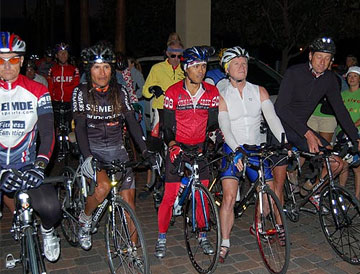 Never mind that a couple of pro athletes had signed on to do the race. Kenny Souza, a world-class duathlete, and Tinker Juarez, the dreadlock-adorned mountain bike racer, were toe-to-toe with the rest of the pack, all of whom were wondering how long it would be before they were eating the dust of these demi-gods.
Never mind that a couple of pro athletes had signed on to do the race. Kenny Souza, a world-class duathlete, and Tinker Juarez, the dreadlock-adorned mountain bike racer, were toe-to-toe with the rest of the pack, all of whom were wondering how long it would be before they were eating the dust of these demi-gods.
Bill had sipped his first bottle of a liquid concoction called Spiz, a pricey high-tech lab food for athletes. It's kind of like a powdered version of Ensure, the stuff old folks slurp out of cans to keep them going, except that Spiz is designed for fueling intense exercise. Theoretically, one could live on Spiz for days while on an adventure.
And if you get tired of it, I'll bet it works great as wallpaper paste.
With 24 ounces of Spiz sloshing around in his belly, Bill and the pack headed out on the streets of LA's north suburbs, early enough in the morning that most of LA was still tucked away in bed. The slight chill in the air was comfortable and would keep everyone from overheating on the first climb of the day, up and over the coastal range. On the other side awaited the high desert. The lush greenery of the start faded quickly into the brown reality of the next 480 miles.
We met Bill about 30 miles into the race at a place where all crews were instructed to wait. The wind was howling like a banshee and the sun was stirring the electrons into a heating frenzy. The leaders blasted through as if they were just on a short club ride; Bill came through about 25 minutes after, and we handed up fresh bottles of Spiz and water.
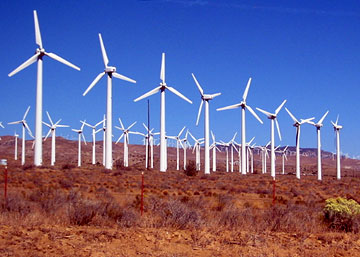 There's a misconception about the desert. Unless you've experienced it, you probably think it is a flat place with occasional sand dunes and maybe a few stray camels. The Mojave is anything but flat (and there are no camels). It may be arid, but it is also very mountainous, with peaks above 10,000 feet commonplace. Thus, the advertised 35,000 feet of vertical climbing in The 508 is no exaggeration. It is a sobering reality.
There's a misconception about the desert. Unless you've experienced it, you probably think it is a flat place with occasional sand dunes and maybe a few stray camels. The Mojave is anything but flat (and there are no camels). It may be arid, but it is also very mountainous, with peaks above 10,000 feet commonplace. Thus, the advertised 35,000 feet of vertical climbing in The 508 is no exaggeration. It is a sobering reality.
But Bill already knew this. Having covered every inch of the course once before, he came prepared with the appropriate gearing (mentally and otherwise) that it would take to cross these speed bumps. Bill's first test was the grind through the Tehachapi range, where the huge windfarm is located. There's a reason why that windfarm is located here. It's very windy.
Little did we know at the time that Bill's stomach was already doing somersaults, with Spiz swishing around in a discomforting ebb and flow. As he would later tell us, that stretch kicked his rear. It's not a particularly hard climb, but the slight bend in the road put everyone straight into a gusty headwind for just a few miles. It was enough to put an early dent in his performance, but he kept pedaling. He knew that this was going to happen sooner or later anyway, so he just dealt with the nausea. In ultra-distance sports, nausea is just part of the landscape. And if you're not real careful, it might land on the landscape.
With the first time station in California City behind us, Bill motored along in good spirits. The leaders had buzzed through an hour faster than Bill in those first 85 miles, but there's old lore about rabbits at The 508. "The first shall be last, and the last shall be first" has been a rule of thumb for years at this race, and the rabbits who lead the charge are often the first to be seen on the side of the road facedown to Mother Earth.
At least it was something to hope for in Bill's case.
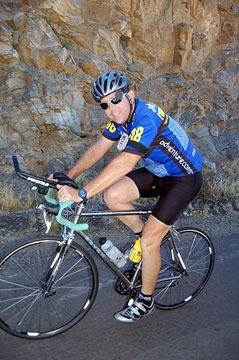 The interior desert towns are steeped in mining history. While the desert may not be known for anything remotely agricultural, it has proven to be a goldmine in minerals and ores. Randsburg is one such town, and today looks like it could be a Hollywood set for a seedy old western were it not for the dozens of offroaders who have co-opted the town and the mountain it sits atop. Rusted hulks of abandoned autos lay in repose alongside abandoned frame buildings whose walls could probably tell many an interesting story. The juxtaposition of Lycra-clad cyclists against leather-protected motorcross bikers was like a chance encounter by people from parallel universes. Eyeball-to-eyeball, the looks on the faces bespoke awe of the different evolutionary tracks emerging from a common two-wheeled DNA.
The interior desert towns are steeped in mining history. While the desert may not be known for anything remotely agricultural, it has proven to be a goldmine in minerals and ores. Randsburg is one such town, and today looks like it could be a Hollywood set for a seedy old western were it not for the dozens of offroaders who have co-opted the town and the mountain it sits atop. Rusted hulks of abandoned autos lay in repose alongside abandoned frame buildings whose walls could probably tell many an interesting story. The juxtaposition of Lycra-clad cyclists against leather-protected motorcross bikers was like a chance encounter by people from parallel universes. Eyeball-to-eyeball, the looks on the faces bespoke awe of the different evolutionary tracks emerging from a common two-wheeled DNA.
Even with a tailwind, the seven-mile climb to Randsburg had been another punch to Bill's gut. Each climb was hurting a little more and causing more unrest inside. He started getting passed by riders we hadn't seen since the start. Two women were ahead of him, and a third started dancing back and forth with Bill, with the two exchanging race position many times for a few hours. Some of the greatest ultra athletes in the world are women, and many a man has been beaten by them. But some men have in the back of their ego a problem being passed by a skirt. Bill isn't one of them. Besides, he had more important things to worry about, like keeping his Spiz inside him.
If ever there were a contest to take honors for being the mining cesspool of the nation, the winner would be Trona, home of the second time station. Masks are almost necessary to keep out the ever-present dust. It stretches the imagination to consider how anyone could live there. The fact that it was nearly deserted may have revealed that this is just a place to work but not live. Which may have been part of the attraction to serial killer Charles Manson. It was not far from Trona that Manson and his devotees drove that old school bus up a jeep road to the Barker Ranch, where they holed up until authorities caught them. The desert is a pretty good place to hide, but it's not perfect.
Shortly after the dirt turnoff toward Manson's place we readied Bill and ourselves for night, which entailed following in the pace van a mere 10-15 feet from Bill's back wheel. We were to remain together all night in this position, never straying one from the other, moving forward only to hand out a fresh bottle to Bill as needed. Before dusk we mixed a couple of gallons of Spiz for the graveyard shift, got Bill's lights ready, and guzzled Diet Coke to load up on caffeine for what was bound to be a tedious night.
The Panamint Range towered to the right. This north-south range forms the western wall of Death Valley to the east. We were northbound until the stop sign at Rt 190, where we would turn right and then begin the Mother of All Climbs: Townes Pass. This elevator shaft is 10 miles up to a low spot in the mountain at nearly 5000 feet elevation. Gradients average 10-13%, but in spots are 18%. In human terms, that's like trying to ride your bike up the stairs.
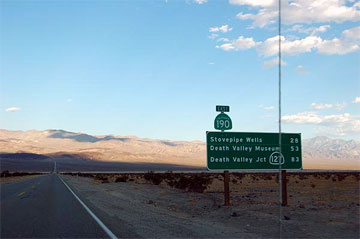 A couple of hours before we reached the stop sign, a cool front came through, right on schedule. The only problem was that Bill wasn't on schedule. He had hoped to be on Route 190 by the time the wind changed to the north, but it wasn't in the cards. Instead, he slogged through what seemed an eternity just to go 20 miles. And his stomach was now issuing notice that it was not at all pleased with this change of weather.
A couple of hours before we reached the stop sign, a cool front came through, right on schedule. The only problem was that Bill wasn't on schedule. He had hoped to be on Route 190 by the time the wind changed to the north, but it wasn't in the cards. Instead, he slogged through what seemed an eternity just to go 20 miles. And his stomach was now issuing notice that it was not at all pleased with this change of weather.
We pulled off at the stop sign for Bill to gather his thoughts and try to settle down. We had already been interspersing Spiz feedings with turkey sandwiches with the hopes that some solid food would bring Bill back to strength. Bill remounted his bike and rolled through the first few miles (the easy part) quite nicely. But then the pitch turned up and Bill's speed slowed to a crawl. We could see him trying to muscle through each crank of the pedal. The body English was saying "This hurts and I can't wait until it's over." I'm sure Bill had some other choice words.
And then Bill stopped abruptly about half-way up the grade. We spilled out of the van and ran to him, catching his bike just as he bowed down to share his Spiz with California.
It was no longer a perfect day.
Craig and Marshall, my colleagues on this mission, joined me in wondering if Bill was headed for the showers. In 2003 he had reported feeling sick at this point, but never actually verified it. We didn't want to abort this early in the race, but when you're this sick, it just isn't much fun to do anything.
Much less keep riding up a mountain.
We were an interesting crew, the three of us from different aspects of Bill's life. Craig works for an electrical supplier. Marshall is a middle school teacher. And I'm one of Bill's riding buddies. Cast into this unlikely scenario, our job was to bond and keep our focus on Bill. But right now all we could see was re-Spiz and a row of lights leading up the mountain.
Townes Pass was lit up that night like a yellow-and-red Christmas tree. For as far as the eye could see there were pace vehicles in tow behind tired racers, each van aglow with its red taillights and the required amber revolving lights on the roof. I pity anyone trying to get to Death Valley that night. We were a slow-moving roadblock.
No sooner had Bill donated Spiz than he hopped back on his bike and resumed his crawl to the summit. He surprised us, for it was like someone rising from their deathbed only to resume living.
A few other riders passed us, but Bill passed a few as well. The ditch becomes a common hangout during races like this. I'll bet Bill felt sorry for those unlucky souls, but at the same time, it had to encourage him as well.
I'm sure Bill wishes he could say that he only had to stop once to pay his fine, but that would be untrue. There were a couple more abrupt stops on the ascent, and each time we began to wonder if Bill was going to make it. After all, Townes Pass is only about 210 miles into the race. There were 300 miles and five more major climbs before the finish.
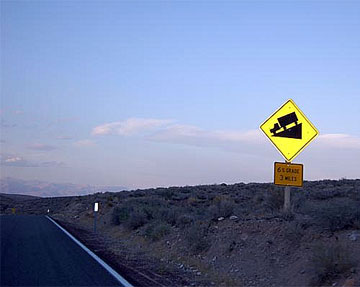 Our GPS unit told the story one foot at a time. We watched the elevation rise ever so slowly until, finally, we were at 4900 feet. All of us could smell the barn, so to speak, and within a couple of minutes, the tell-tale "truck-on-a-triangle" yellow diamond sign stood resolutely proclaiming a huge downhill lay ahead.
Our GPS unit told the story one foot at a time. We watched the elevation rise ever so slowly until, finally, we were at 4900 feet. All of us could smell the barn, so to speak, and within a couple of minutes, the tell-tale "truck-on-a-triangle" yellow diamond sign stood resolutely proclaiming a huge downhill lay ahead.
We stopped long enough for Bill to wolf down another turkey sandwich (good thing we bought two packs of lunch meat the day before!) and add a windbreaker for the bone-chilling descent into the pits of earthly hell: an 18-mile drop from nearly 5000 feet elevation to sea level and below.
That descent is a trip in itself. In 2003, Bill was shaking so mightily in the cold that he could hardly control his bike. We passed a couple of awestruck coyotes on the roadside that year, no doubt wondering who in their right mind would be riding a bike in the middle of the night. This year was not quite as cold, but Bill was still shivering.
But like a frog in a kettle of water, it's often tough to recognize the boiling point until it's too late. As we dropped and dropped, we watched the thermometer go the other direction. In 2003, Bill went from shivering to drifting off to sleep and weaving all over the road. This time we warned him to keep pedaling just to keep his pulse up. He managed to stave off sleep this time, but it is no easy task when you have just spent yourself and then allow your body to shut down as you roll through the downhill.
At the bottom Bill told us what we already figured to be true: "That was the hardest thing I have ever done before." Townes Pass is not easy even when rested, but when you're tired and puking, it can be plain miserable. It took almost three hours to go 10 miles, and Bill was now behind his 2003 pace. Things were not looking up.
Death Valley is one of the most bizarre places on earth. Surrounded by 10,000 foot peaks, it is home to the highest recorded temperature in North America (134 degrees on 10th July 1913). It is also home to the lowest point in the continent at Badwater (-282 feet). Ironically, California's Mt. Whitney is less than 150 miles away, and at 14,495 feet, it is the highest point in California.
Remember, I told you California is out of the ordinary.
It's hard to believe there could be less vegetation than we saw the day before, but that's what we found in Death Valley. If you could transport yourself to Mars this is what you would see.
Fortunately for Bill, Death Valley is bike-friendly, meaning it is rather flat. Parts of the road were brand new, having been replaced following washouts earlier this year. But the remainder was as rough as ever. I suppose the only way to get new roads out there is to have a disaster.
Along the left side of the road, cliffs rise abruptly, creating spooky shadows and the feeling that you have fallen into an abyss. The aptly-named Furnace Creek community features a guest ranch and posh hotel that remain full much of the year, especially with European tourists who want to turn up the heat.
It is at the time station in Furnace Creek that the race really begins. Everything thus far has been mere warm-up. Furnace Creek has been the burial ground for many a 508 racer, having spent everything on the wrong half of the race.
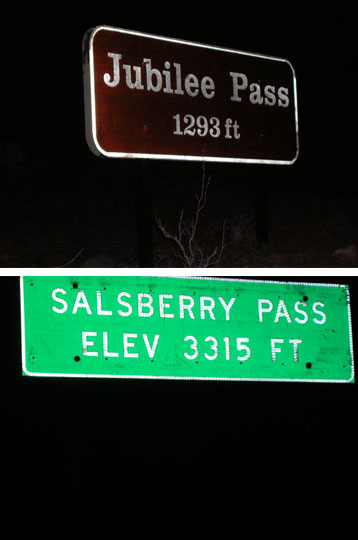 But it didn't happen this year. The leaders reached Furnace Creek in great shape, and just kept going. I think Bill secretly hoped to see the pros in the ditch paying their dues as well, but it was not to happen. And so we rolled along through Death Valley throughout the night, with Orion the Hunter keeping us company in the eastern sky.
But it didn't happen this year. The leaders reached Furnace Creek in great shape, and just kept going. I think Bill secretly hoped to see the pros in the ditch paying their dues as well, but it was not to happen. And so we rolled along through Death Valley throughout the night, with Orion the Hunter keeping us company in the eastern sky.
Just as we had to cross a tall mountain range to enter Death Valley, we had to cross another to leave. At the southern end of the national park is the double-barreled Jubilee-Salsberry passes, which start with four miles of foreplay up Jubilee, a one mile descent, and then nine miles of knee-burning up Salsberry. If Townes Pass didn't get you, then these might just do the job.
After several hours of peaceful cycling, we all hoped that Bill's stomach problems were over. But shortly after we started climbing, it all came back to him. Reduced to a crawl again, Bill had to stop more than once to expel his meal.
About this time the dawn's first light began to appear in the east. This is the coldest part of the night, and the desert is no stranger to cold. A land of extremes, you can go from broiling to frozen in 12 hours here. Bill looked cold as he neared the top of Salsberry after another tedious climb. We hoped this one wouldn't be his Waterloo, but we couldn't be sure. At one of his emergency stops, Bill confided to me that he was beginning to wonder if it was really worth it to keep going.
I ignored him.
Once an athlete starts thinking like this it becomes increasingly difficult to keep going. Suddenly all those household chores you left behind start to look appealing. Guilt creeps in for all the time you spent away from family while training. And then here's all the money you blew coming here in the first place. Thoughts of "What the hell am I doing out here?" dominate the mind and can send you packing in a heartbeat.
But after each big climb must come a big descent, and Bill cheered up as we rolled through the time station in Shoshone a full 2000 feet below the summit. It was there that we learned one of the women ahead of Bill (a woman from Lubbock, as it turns out) had called it quits here a couple of hours earlier. She had a litany of excuses, but basically just lost concentration.
We told Bill that she had dropped, and he wanted to know what happened. "She had a pile of reasons, but none sounded very good," I replied.
"So you're not going to let me quit?"
"Nope. Keep pedaling."
And so Bill kept pedaling. Every hill caused his stomach to revolt, but by this time all of us knew he could work through it. This was becoming old hat. Pedal. Puke. Coast.
Hey, I can do this.
With sunshine in our faces, Bill made good time into Baker, the dusty tow-truck town along I-15. Only a few hundred hardy souls call this place home. It's an oasis of sorts in the desert, with a few motels and fast food joints, and tow trucks to rescue motorists stupid enough to run their AC while driving uphill. Imagine that...using the AC in the desert.
The Baker city limit sign is almost famous, having appeared in the liner notes of Sheryl Crow's first album. I don't know what her attraction to the place is. Maybe it is the Del Taco, because it certainly was for us. While Bill was getting checked in at the time station, the crew split up to get gas, groceries, and lunch. I ran down the street to Del Taco and bought a dozen burritos, gathering a few snickers from people as I walked out the door with my bounty.
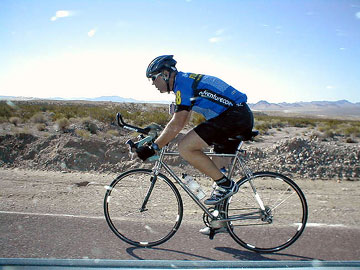 Those burritos were the first real food we'd had since Friday night. We vowed to not give Bill any unless he asked for some. A burrito in the belly at this point in the race could be the final nail in his coffin.
Those burritos were the first real food we'd had since Friday night. We vowed to not give Bill any unless he asked for some. A burrito in the belly at this point in the race could be the final nail in his coffin.
At one short rest stop up the long grade on Kelbaker Road, Bill spied the burritos laying across the dashboard. He started drooling, and we knew we had to give up one. He inhaled it while we crossed our fingers.
But the burrito worked wonders and Bill made good time up that 22-mile hill. Thankfully it was 20 degrees cooler this time; in 2003 Bill was almost nuked in the searing desert sun.
Still, Bill had to overcome another mental low point. I-15 represented an escape hatch. We could just go to Vegas and play with what cash remained. Never mind that Bill's wife and sister-in-law had driven out to see him on in Baker. They no doubt cheered him up, but it was getting easier to rationalize quitting. And it was going to get even easier when we crossed under I-40 ahead. Good thing, though, that at that point there are only another 80 miles to go.
To say that Bill's ride across the Mojave National Preserve south of Baker was hard would be an understatement. Bill wanted so badly to go home, even after the burrito. But we weren't going to let that happen. We had nothing else to do other than make sure Bill reached 29 Palms.
To add insult to injury, the wind kept playing fits on Bill. Sometimes it was favorable, but at other times it was a crossing wind, and even a headwind. He slowed to a near crawl atop Granite Pass, the ninth climb of the ride, and we wondered if Bill was going to have to walk the rest of the way.
As he descended, though, the wind subsided. The winds are most fierce at the tops of the climbs, and so Bill once again picked up speed as we neared Amboy, the last town before the finish line.
Amboy sits on a lonely section of old Route 66, and I'm sure Bill felt like a character out of a Steinbeck novel as he trudged along toward the promised land. All through this section Bill kept fretting aloud about the final climb up the Sheep Hole Mountains. It starts innocently but gets steeper the farther you go, and with 480 miles in your legs, it hurts like nothing else you've experienced thus far.
Bill bravely made his way toward the climb and locked his sights on 29 Palms. He was now over the hump in his mind. He just had one more hump in the road separating himself from an official finish. Resigned to being several hours slower than in 2003, Bill finally decided that it is far better to have a slower finish than to have the dreaded DNF behind your name (Did Not Finish). Those three letters will cause you to hang your head in shame for years. No, it was far more dignified to swallow pride and just finish the darn thing no matter how long it took. After all, at 51, no one could say Bill was a slouch.
Darkness had set in again by this time. It's increasingly difficult to stay awake into the second night, but Bill had no choice in the matter. It was stay awake and ride, or forever suffer a defeat at his own hands.
That last climb was more tedious than any of the earlier ones. Bill stopped several times. Marshall struggled to keep the van from overheating while driving 5 m.p.h. Craig and I jumped out many times to see what Bill needed each time he stopped. And then we reached the top. All that was left were a simple ride into 29 Palms. Less than 25 miles to go. Those lights in the distance are your goal. Keep going. You can do it.
Sometimes the hardest miles of a race are the ones at the end. Not because you have come so far, but because you have so little to do. Your body wants so badly to be finished. You savor a shower and real food. Your bottom wants a soft comfy chair. Your feet want to be elevated. But those final miles come so agonizingly slow. It's as if you're in one of those personal nightmares that have you trying to outrun some demon, but the best you can do is slo-mo.
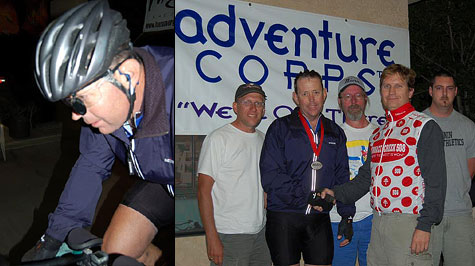 Finally we saw the city limits sign. Bill was cold. He was tired. His fuel gauge read "E" and the orange light had been on for a few hours. But he kept going. He didn't care if anyone else passed him, because he was no longer racing against them. It was Bill vs. Bill, and the real Bill was determined to win.
Finally we saw the city limits sign. Bill was cold. He was tired. His fuel gauge read "E" and the orange light had been on for a few hours. But he kept going. He didn't care if anyone else passed him, because he was no longer racing against them. It was Bill vs. Bill, and the real Bill was determined to win.
The clock read three minutes before midnight when Bill crossed the finish line, 40 hours and 57 minutes after leaving LA. Bill had a smile on his face, and we shared hugs all around. I offered him $10 for his bike, but he just laughed.
In 2003 Bill defeated Bubba Red Neck at The 508. This time Bill defeated himself. ultra-distance athletes know all too well that your worst enemy can be yourself.
For Bill to overcome this most serious of nemeses and gracefully accept that finishing slower is better than not finishing, simply shouts of his character. He had turned himself inside out to finish The 508, and it was what is on his inside that won it for him.
And at the end of the ride, it was a perfect day again.